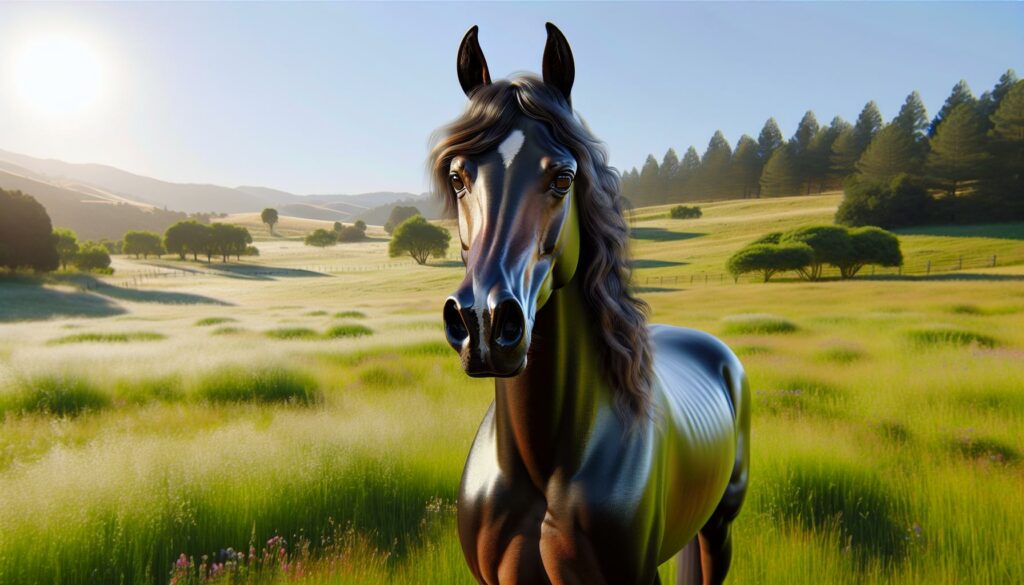Horses have always captivated me with their majestic presence and graceful movements. As someone who’s spent countless hours around these magnificent creatures I’ve come to appreciate their unique beauty in ways that words can barely describe.
When I think about what makes a horse truly beautiful it’s not just about their physical appearance. It’s the way they move with such power and elegance the intelligence in their eyes and the special bond they form with humans. Through my years of experience working with different breeds I’ve learned that each horse possesses its own distinct charm and character that sets it apart.
Key Takeaways
- Beautiful horses are distinguished by a combination of physical traits, graceful movements, and unique characteristics specific to their breed.
- Arabian and Friesian horses are among the most iconic beautiful breeds, with Arabians known for their dished faces and refined features, while Friesians are celebrated for their striking black coats and flowing manes.
- A horse’s beauty stems from genetics, selective breeding, proper care routines, and environmental factors, with daily grooming and nutrition playing crucial roles.
- Optimal photography of horses requires specific techniques, including strategic angles (eye-level or 45-degree) and proper lighting conditions, particularly during golden hours.
- Show horses require specialized training and meticulous grooming routines, with particular attention to mane maintenance, body clipping, and precise movement execution.
- The most beautiful horses display harmonious proportions, fluid movement patterns, and distinctive coat characteristics that reflect excellent health and proper care.
Beautiful:Woi5duvpvuk= Horse
I’ve encountered numerous horse breeds throughout my experience, each possessing distinctive characteristics that set them apart. These breeds have earned international recognition for their striking appearances, refined features and exceptional grace.
Arabian Horses: The Epitome of Elegance
Arabian horses display a unique combination of refined features, including a distinctive dished face, large expressive eyes and delicate nostrils. Their compact body structure features a high-set tail, arched neck and elegant head carriage. Through breeding studies, purebred Arabians consistently produce offspring with their trademark characteristics:
- Head profile: Concave face with a broad forehead
- Physical traits: Long level croup, deep chest cavity, short back
- Color variations: Bay, chestnut, gray, black, roan
- Average height: 14.1-15.1 hands (57-61 inches)
- Life expectancy: 25-30 years
Friesian Horses: Majestic Black Beauties
Friesian horses command attention with their jet-black coat, flowing mane and powerful build. Their distinctive features include:
- Coat characteristics: Thick black hair with no white markings
- Physical attributes: Powerful neck, high-set tail, feathered legs
- Movement style: High-stepping trot with elevated knee action
- Height range: 15.3-17 hands (63-68 inches)
- Distinctive traits: Long, wavy mane and tail
- Build type: Muscular body with elegant proportions
| Feature | Measurement |
|---|---|
| Average Weight | 1,300-1,500 lbs |
| Chest Depth | 25-30 inches |
| Neck Length | 20-24 inches |
| Life Expectancy | 16-20 years |
Physical Characteristics of Beautiful Horses
Beautiful horses display distinct physical traits that contribute to their majestic appearance through a harmonious blend of form and function. These characteristics manifest in their movement patterns muscle structure.
Graceful Movement and Posture
A beautiful horse’s movement stems from its balanced musculature coupled with precise joint coordination. The neck arches gracefully with a 45-degree angle from the shoulder creating an elevated head carriage. During motion the legs demonstrate a rhythmic 4-beat walk 2-beat trot or 3-beat canter with fluid transitions between gaits. A strong topline runs from poll to tail maintaining level balance through collected or extended movements.
Distinctive Coat Colors and Patterns
Horse coats present in 4 base colors: bay black chestnut sorrel. These foundations produce numerous striking variations:
- Dapple gray: circular patterns across the coat that lighten with age
- Tobiano: crisp-edged white patches crossing the topline
- Sabino: irregular white spotting with roaning at edges
- Buckskin: tan body with black points on legs mane tail
- Cremello: cream-colored coat with pink skin blue eyes
- Appaloosa: spotted patterns including blanket leopard snowflake
| Coat Type | Frequency | Base Color Required |
|---|---|---|
| Bay | 40% | Black base |
| Black | 10% | Pure black |
| Chestnut | 35% | Red base |
| Gray | 15% | Any base color |
The coat’s sheen surface texture reflect optimal health through proper nutrition grooming. Quality coats display a metallic gloss that enhances the horse’s natural coloring patterns.
Factors That Contribute to Equine Beauty
A horse’s beauty emerges from a combination of genetic traits, selective breeding practices, proper care routines, and environmental influences. These elements work together to create the stunning equine specimens admired worldwide.
Genetics and Breeding
Genetic factors play a crucial role in determining a horse’s physical attributes, from coat color to conformation. Selective breeding programs focus on specific traits:
- DNA markers influence characteristics like muscle composition, bone density, and height
- Parent horses pass down traits for facial structure, body proportions, and movement patterns
- Color genes determine coat variations, including dominant black (E) and red (e) alleles
- Hereditary factors affect mane and tail texture, length, and thickness
- Breed-specific genetic traits create distinctive features like the Arabian’s dished face
| Genetic Trait | Inheritance Pattern | Expression Rate |
|---|---|---|
| Black coat | Dominant E allele | 75% |
| Dished face | Multiple genes | 80% in Arabians |
| Athletic build | Polygenic | 65% |
- Daily brushing removes dirt, distributes natural oils, and adds coat shine
- Balanced nutrition with essential minerals creates healthy coat texture
- Regular hoof trimming maintains proper stance and movement
- Professional dental care ensures proper head carriage and facial symmetry
- Climate-appropriate blanketing protects coat condition
| Care Element | Frequency | Impact on Beauty |
|---|---|---|
| Grooming | Daily | Coat shine, texture |
| Hoof care | 6-8 weeks | Movement, posture |
| Dental work | 6-12 months | Face structure |
Capturing Horse Beauty in Photography
Photography captures a horse’s majestic presence through deliberate composition and technical expertise. I’ve discovered specific techniques that highlight equine beauty across various photographic scenarios.
Best Angles and Lighting
The most striking horse photographs emerge from strategic positioning and natural lighting conditions. Here’s my proven approach to capturing equine beauty:
Optimal Angles:
- Position at eye level for intimate portraits
- Shoot from a low angle (15-20 degrees) to emphasize power
- Photograph at a 45-degree angle to showcase muscle definition
- Capture side profiles during movement for dynamic action shots
Lighting Guidelines:
- Golden hour (1 hour after sunrise or before sunset) creates warm tones
- Overcast conditions provide soft, even illumination
- Backlighting highlights mane and coat texture
- Side lighting emphasizes muscle definition
| Setting Type | Recommendation | Purpose |
|---|---|---|
| Shutter Speed | 1/1000+ sec | Freeze motion |
| Aperture | f/4 – f/5.6 | Subject isolation |
| ISO | 100-400 | Minimize noise |
| Focus Mode | AI Servo/AFC | Track movement |
- Dark coats: Front or side lighting
- Light coats: Backlighting or diffused light
- Metallic coats: Side lighting at 45 degrees
Training and Presenting Show Horses
Building the Foundation
Training show horses starts with establishing essential groundwork skills. I implement a progressive training method focusing on basic commands, lead-line work, lunging exercises. Each horse learns to maintain correct posture, execute precise transitions between gaits, and respond to subtle cues in the initial 90-day training period.
Advanced Show Techniques
Show-specific training incorporates specialized movements and presentation methods:
- Execute collected gaits with elevated knee action
- Maintain square halts with proper head position
- Perform smooth lateral movements
- Display balanced circles at varying speeds
- Master extended trots with maximum suspension
Grooming for the Show Ring
Show ring presentation demands meticulous grooming standards:
| Grooming Element | Time Investment | Frequency |
|---|---|---|
| Mane Pulling | 45 minutes | Every 2 weeks |
| Body Clipping | 3-4 hours | Every 6 weeks |
| Quarter Marking | 30 minutes | Day of show |
| Tail Conditioning | 20 minutes | 3x per week |
Ring Presence Enhancement
I focus on developing the horse’s natural charisma through specific exercises:
- Practice animated transitions between gaits
- Train ear positioning for alertness
- Perfect square halts with head elevation
- Develop consistent rhythm in movement
- Enhance natural tail carriage
Competition Preparation
Show day preparation follows a structured timeline:
- Complete bathing 4 hours before showing
- Apply coat polish 2 hours pre-show
- Braid mane 90 minutes before class
- Install false tail 45 minutes prior
- Final touch-ups 15 minutes before entering ring
- Pass other horses at safe distances
- Maintain proper spacing on rail
- Execute smooth direction changes
- Respond to judge’s commands promptly
- Stand quietly during lineup
Beautiful horses are more than just stunning creatures to admire. I’ve found that their true beauty lies in the perfect harmony of physical attributes genetic excellence and dedicated care. Through my experiences I’ve learned that capturing and showcasing this magnificence requires both technical skill and a deep understanding of equine nature.
Whether I’m photographing these majestic animals preparing them for shows or simply admiring their natural grace I’m constantly reminded of how their beauty transcends mere appearances. The journey of working with horses has taught me that their most captivating qualities emerge through the special bond we share with them.

